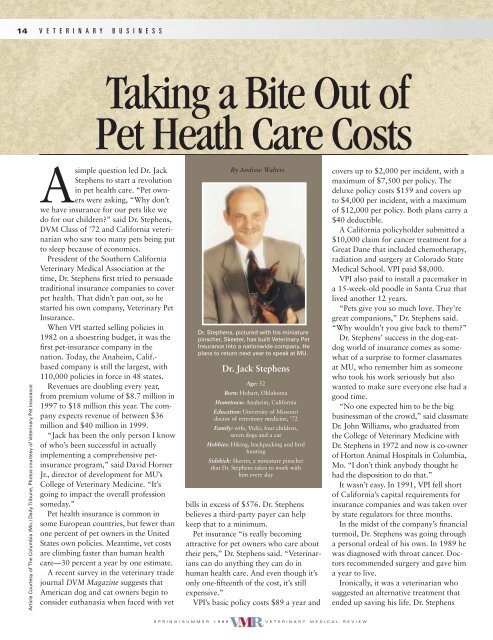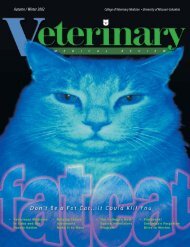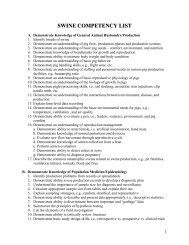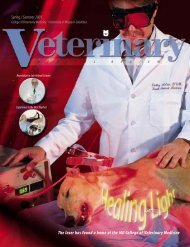... page 10 - University of Missouri College of Veterinary Medicine
... page 10 - University of Missouri College of Veterinary Medicine
... page 10 - University of Missouri College of Veterinary Medicine
Create successful ePaper yourself
Turn your PDF publications into a flip-book with our unique Google optimized e-Paper software.
14 V E T E R I N A R Y B U S I N E S S<br />
Article Courtesy <strong>of</strong> The Columbia (Mo.) Daily Tribune, Photos courtesy <strong>of</strong> <strong>Veterinary</strong> Pet Insurance<br />
Taking a Bite Out <strong>of</strong><br />
Pet Heath Care Costs<br />
Asimple question led Dr. Jack<br />
Stephens to start a revolution<br />
in pet health care. “Pet owners<br />
were asking, “Why don’t<br />
we have insurance for our pets like we<br />
do for our children?” said Dr. Stephens,<br />
DVM Class <strong>of</strong> ’72 and California veterinarian<br />
who saw too many pets being put<br />
to sleep because <strong>of</strong> economics.<br />
President <strong>of</strong> the Southern California<br />
<strong>Veterinary</strong> Medical Association at the<br />
time, Dr. Stephens first tried to persuade<br />
traditional insurance companies to cover<br />
pet health. That didn’t pan out, so he<br />
started his own company, <strong>Veterinary</strong> Pet<br />
Insurance.<br />
When VPI started selling policies in<br />
1982 on a shoestring budget, it was the<br />
first pet-insurance company in the<br />
nation. Today, the Anaheim, Calif.based<br />
company is still the largest, with<br />
1<strong>10</strong>,000 policies in force in 48 states.<br />
Revenues are doubling every year,<br />
from premium volume <strong>of</strong> $8.7 million in<br />
1997 to $18 million this year. The company<br />
expects revenue <strong>of</strong> between $36<br />
million and $40 million in 1999.<br />
“Jack has been the only person I know<br />
<strong>of</strong> who’s been successful in actually<br />
implementing a comprehensive petinsurance<br />
program,” said David Horner<br />
Jr., director <strong>of</strong> development for MU’s<br />
<strong>College</strong> <strong>of</strong> <strong>Veterinary</strong> <strong>Medicine</strong>. “It’s<br />
going to impact the overall pr<strong>of</strong>ession<br />
someday.”<br />
Pet health insurance is common in<br />
some European countries, but fewer than<br />
one percent <strong>of</strong> pet owners in the United<br />
States own policies. Meantime, vet costs<br />
are climbing faster than human health<br />
care—30 percent a year by one estimate.<br />
A recent survey in the veterinary trade<br />
journal DVM Magazine suggests that<br />
American dog and cat owners begin to<br />
consider euthanasia when faced with vet<br />
By Andrew Walters<br />
Dr. Stephens, pictured with his miniature<br />
pinscher, Skeeter, has built <strong>Veterinary</strong> Pet<br />
Insurance into a nationwide company. He<br />
plans to return next year to speak at MU.<br />
Dr. Jack Stephens<br />
Age: 52<br />
Born: Hobart, Oklahoma<br />
Hometown: Anaheim, California<br />
Education: <strong>University</strong> <strong>of</strong> <strong>Missouri</strong><br />
doctor <strong>of</strong> veterinary medicine, ’72<br />
Family: wife, Vicki, four children,<br />
seven dogs and a cat<br />
Hobbies: Hiking, backpacking and bird<br />
hunting<br />
Sidekick: Skeeter, a miniature pinscher<br />
that Dr. Stephens takes to work with<br />
him every day<br />
bills in excess <strong>of</strong> $576. Dr. Stephens<br />
believes a third-party payer can help<br />
keep that to a minimum.<br />
Pet insurance “is really becoming<br />
attractive for pet owners who care about<br />
their pets,” Dr. Stephens said. “Veterinarians<br />
can do anything they can do in<br />
human health care. And even though it’s<br />
only one-fifteenth <strong>of</strong> the cost, it’s still<br />
expensive.”<br />
VPI’s basic policy costs $89 a year and<br />
S P R I N G / S U M M E R 1 9 9 9 V E T E R I N A R Y M E D I C A L R E V I E W<br />
covers up to $2,000 per incident, with a<br />
maximum <strong>of</strong> $7,500 per policy. The<br />
deluxe policy costs $159 and covers up<br />
to $4,000 per incident, with a maximum<br />
<strong>of</strong> $12,000 per policy. Both plans carry a<br />
$40 deductible.<br />
A California policyholder submitted a<br />
$<strong>10</strong>,000 claim for cancer treatment for a<br />
Great Dane that included chemotherapy,<br />
radiation and surgery at Colorado State<br />
Medical School. VPI paid $8,000.<br />
VPI also paid to install a pacemaker in<br />
a 15-week-old poodle in Santa Cruz that<br />
lived another 12 years.<br />
“Pets give you so much love. They’re<br />
great companions,” Dr. Stephens said.<br />
“Why wouldn’t you give back to them?”<br />
Dr. Stephens’ success in the dog-eatdog<br />
world <strong>of</strong> insurance comes as somewhat<br />
<strong>of</strong> a surprise to former classmates<br />
at MU, who remember him as someone<br />
who took his work seriously but also<br />
wanted to make sure everyone else had a<br />
good time.<br />
“No one expected him to be the big<br />
businessman <strong>of</strong> the crowd,” said classmate<br />
Dr. John Williams, who graduated from<br />
the <strong>College</strong> <strong>of</strong> <strong>Veterinary</strong> <strong>Medicine</strong> with<br />
Dr. Stephens in 1972 and now is co-owner<br />
<strong>of</strong> Horton Animal Hospitals in Columbia,<br />
Mo. “I don’t think anybody thought he<br />
had the disposition to do that.”<br />
It wasn’t easy. In 1991, VPI fell short<br />
<strong>of</strong> California’s capital requirements for<br />
insurance companies and was taken over<br />
by state regulators for three months.<br />
In the midst <strong>of</strong> the company’s financial<br />
turmoil, Dr. Stephens was going through<br />
a personal ordeal <strong>of</strong> his own. In 1989 he<br />
was diagnosed with throat cancer. Doctors<br />
recommended surgery and gave him<br />
a year to live.<br />
Ironically, it was a veterinarian who<br />
suggested an alternative treatment that<br />
ended up saving his life. Dr. Stephens
















